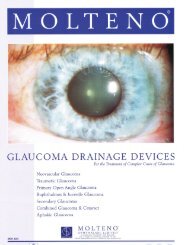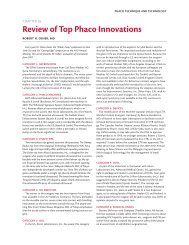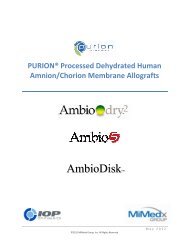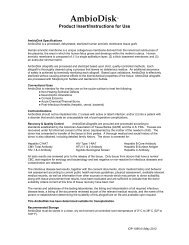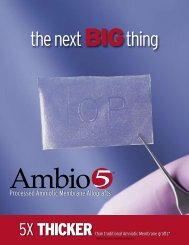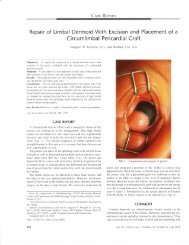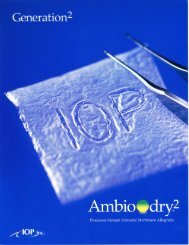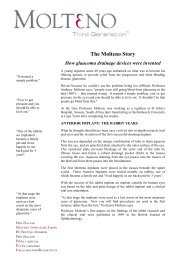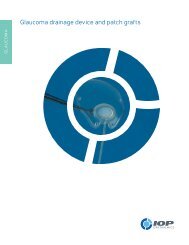BSS Plus - Eyetube.net
BSS Plus - Eyetube.net
BSS Plus - Eyetube.net
Create successful ePaper yourself
Turn your PDF publications into a flip-book with our unique Google optimized e-Paper software.
<strong>BSS</strong> <strong>Plus</strong>®DESCRIPTION: <strong>BSS</strong> PLUS® is a sterile intraocular irrigating solution for use during all intraocular surgicalprocedures, including those requiring a relatively long intraocular perfusion time (e.g., pars planavitrectomy, phacoemulsification, extracapsular cataract extraction/lens aspiration, anterior segmentreconstruction, etc.). The solution does not contain a preservative and should be prepared just prior to usein surgery.Part I: Part I is a sterile 480 mL solution in a 500 mL single-dose bottle to which the Part II concentrate isadded. Each mL of Part I contains: sodium chloride 7.44 mg, potassium chloride 0.395 mg, dibasic sodiumphosphate 0.433 mg, sodium bicarbonate 2.19 mg, hydrochloric acid and/or sodium hydroxide (to adjustpH), in water for injection.Part II: Part II is a sterile concentrate in a 20 mL single-dose vial for addition to Part I. Each mL of Part IIcontains: calcium chloride dihydrate 3.85 mg, magnesium chloride hexahydrate 5 mg, dextrose 23 mg,glutathione disulfide (oxidized glutathione) 4.6 mg, in water for injection.After addition of <strong>BSS</strong> PLUS Part II to the Part I bottle, each mL of the reconstituted product contains: sodiumchloride 7.14 mg, potassium chloride 0.38 mg, calcium chloride dihydrate 0.154 mg, magnesium chloridehexahydrate 0.2 mg, dibasic sodium phosphate 0.42 mg, sodium bicarbonate 2.1 mg, dextrose 0.92 mg,glutathione disulfide (oxidized glutathione) 0.184 mg, hydrochloric acid and/or sodium hydroxide (to adjustpH), in water for injection.The reconstituted product has a pH of approximately 7.4. Osmolality is approximately 305 mOsm.CLINICAL PHARMACOLOGY: None of the components of <strong>BSS</strong> PLUS are foreign to the eye, and <strong>BSS</strong> PLUShas no pharmacological action. Human perfused cornea studies have shown <strong>BSS</strong> PLUS to be an effectiveirrigation solution for providing corneal detumescence and maintaining corneal endothelial integrityduring intraocular perfusion. An in vivo study in rabbits has shown that <strong>BSS</strong> PLUS is more suitable thannormal saline or Balanced Salt Solution for intravitreal irrigation because <strong>BSS</strong> PLUS contains the appropriatebicarbonate, pH, and ionic composition necessary for the maintenance of normal retinal electrical activity.Human in vivo studies have demonstrated <strong>BSS</strong> PLUS to be safe and effective when used during surgicalprocedures such as pars plana vitrectomy, phacoemulsification, cataract extraction/lens aspiration, anteriorsegment reconstruction. No differences have been observed between adults and pediatric patients followinguse of this drug product.INDICATIONS AND USAGE: <strong>BSS</strong> PLUS is indicated for use as an intraocular irrigating solution duringintraocular surgical procedures involving perfusion of the eye.CONTRAINDICATIONS: There are no specific contraindications to the use of <strong>BSS</strong> PLUS; however,contraindications for the surgical procedure during which <strong>BSS</strong> PLUS is to be used should be strictly adheredto.WARNINGS: For IRRIGATION during ophthalmic surgery only. Not for injection or intravenous infusion. Donot use unless product is clear, seal is intact, vacuum is present and container is undamaged. Do not use ifproduct is discolored or contains a precipitate.PRECAUTIONS: DO NOT USE <strong>BSS</strong> PLUS UNTIL PART I IS FULLY RECONSTITUTED WITH PART II. Discard unusedcontents. <strong>BSS</strong> PLUS does not contain a preservative; therefore, do not use this container for more than onepatient. Do not use additives other than <strong>BSS</strong> PLUS Concentrate Part II (20 mL) with this product. Tissuedamage could result if other drugs are added to product. DISCARD ANY UNUSED PORTION SIX HOURSAFTER PREPARATION. Studies suggest that intraocular irrigating solutions which are iso-osmotic with normalaqueous fluids should be used with caution in diabetic patients undergoing vitrectomy since intraoperativelens changes have been observed.There have been reports of corneal clouding or edema following ocular surgery in which <strong>BSS</strong> PLUS was usedas an irrigating solution. As in all surgical procedures appropriate measures should be taken to minimizetrauma to the cornea and other ocular tissues.Preparation: Reconstitute <strong>BSS</strong> PLUS® Intraocular Irrigating Solution just prior to use in surgery. Follow thesame strict aseptic procedures in the reconstitution of <strong>BSS</strong> PLUS as is used for intravenous additives. Removethe blue flip-off seal from the <strong>BSS</strong> PLUS Part I (480 mL) bottle. Remove the blue flip-off seal from the <strong>BSS</strong>PLUS Part II (20 mL) vial. Clean and disinfect the rubber stoppers on both containers by using sterile alcoholwipes. Transfer the contents of the Part II vial to the Part I bottle using a <strong>BSS</strong> PLUS Vacuum Transfer Device(provided). An alternative method of solution transfer may be accomplished by using a 20 mL syringe toremove the Part II solution from the vial and transferring exactly 20 mL to the Part I container through theouter target area of the rubber stopper. An excess volume of Part II is provided in each vial. Gently agitate
the contents to mix the solution. Place a sterile cap on the bottle. Remove the tear-off portion of the label.Record the time and date of reconstitution and the patient’s name on the bottle label.Geriatric Use: No overall differences in safety or effectiveness have been observed between elderly andyounger patients.ADVERSE REACTIONS: Postoperative inflammatory reactions as well as incidents of corneal edema andcorneal decompensation have been reported. Their relationship to the use of <strong>BSS</strong> PLUS has not beenestablished.OVERDOSAGE: The solution has no pharmacological action and thus no potential for overdosage. However,as with any intraocular surgical procedure, the duration of intraocular manipulation should be kept to aminimum.DOSAGE AND ADMINISTRATION: The solution should be used according to the standard technique employedby the operating surgeon. Use an administration set with an air-inlet in the plastic spike since the bottledoes not contain a separate airway tube. Follow the directions for the particular administration set to beused. Insert the spike aseptically into the bottle through the center target area of the rubber stopper. Allowthe fluid to flow to remove air from the tubing before intraocular irrigation begins. If a second bottle isnecessary to complete the surgical procedure, ensure that the vacuum is vented from the second bottleBEFORE attachment to the administration set.HOW SUPPLIED: <strong>BSS</strong> PLUS is supplied in two packages for reconstitution prior to use: a 500 mL glass bottlecontaining 480 mL (Part I) and a 20 mL glass vial (Part II); both using grey butyl stoppers and aluminumseals with polypropylene flip-off caps. See the PRECAUTIONS section regarding reconstitution of the solution.NDC 0065-0800-50.Storage: Store Part I and Part II at 2° - 25°C (36° - 77°F). DO NOT FREEZE. Discard prepared solution after sixhours.Rx OnlyDisCoVisc®DisCoVisc® Ophthalmic Viscosurgical Device (Sodium Chondroitin Sulfate – Sodium Hyaluronate).Description: DisCoVisc® Ophthalmic Viscosurgical Device has an intermediate cohesive/dispersive index (CDI)and can best be described as the first viscous dispersive viscoelastic and is optimized for the entire surgicalprocedure.Indications: DisCoVisc® Ophthalmic Viscosurgical Device is indicated for use during surgery in the anteriorsegment of the eye. It is designed to create and maintain space, to protect the corneal endothelium andother intraocular tissues and to manipulate tissues during surgery. It may also be used to coat intraocularlenses and instruments during cataract extraction and IOL insertion.Warnings: Failure to follow assembly instructions or use of an alternate cannula may result in cannuladetachment and potential patient injury.Precautions: Precautions are limited to those normally associated with the surgical procedure beingperformed. Although sodium hyaluronate and sodium chondroitin sulfate are highly purified biologicalpolymers, the physician should be aware of the potential allergic risks inherent in the use of any biologicalmaterial.Adverse Reactions: DisCoVisc® Ophthalmic Viscosurgical Device was very well tolerated in nonclinical andclinical studies. A transient rise in intraocular pressure in the early postoperative period may be expecteddue to the presence of sodium hyaluronate, which has been shown to effect such a rise. It is thereforerecommended that DisCoVisc be removed from the anterior chamber by thorough irrigation and/oraspiration at the end of surgery to minimize postoperative IOP increases. Do not overfill anterior chamber.ATTENTION: Reference the Physician Labeling/Directions for Use for a complete listing of indications,warnings and precautions.CAUTION: FEDERAL (USA) LAW RESTRICTS THIS DEVICE TO THE SALE BY OR ON THE ORDER OF A PHYSICIAN.U.S. Patent Nos. 5,273,056; 5,876,379 and 6,051,560.DuoVisc®DUOVISC® Viscoelastic System is designed to give two viscoelastic materials with different physico-chemicalproperties that can be used differently and/or sequentially to perform specific tasks during a cataractprocedure. DUOVISC® Viscoelastic System consists of VISCOAT® Ophthalmic Viscosurgical Device andPROVISC® Ophthalmic Viscosurgical Device.CAUTION: Federal law restricts this device to sale by or on the order of a physician.
Viscoat® (Sodium Chondroitin Sulfate – Sodium Hyaluronate) Ophthalmic Viscosurgical DeviceIndications: Viscoat is indicated for use as an ophthalmic surgical aid in anterior segment proceduresincluding cataract extraction and intraocular lens (IOL) implantation. Viscoat maintains a deep anteriorchamber during anterior segment surgeries, enhances visualization during the surgical procedure, andprotects the corneal endothelium and other ocular tissues. The viscoelasticity of the solution maintains thenormal position of the vitreous face and prevents formation of a flat chamber during surgery.Warnings: Failure to follow assembly instructions or use of an alternate cannula may result in cannuladetachment and potential patient injury.Precautions: Precautions are limited to those normally associated with the surgical procedure beingperformed. Although sodium hyaluronate and sodium chondroitin sulfate are highly purified biologicalpolymers, the physician should be aware of the potential allergic risks inherent in the use of any biologicalmaterial.Adverse Reactions: Viscoat has been extremely well tolerated in human and animal studies. A transientrise in intraocular pressure in the early postoperative period may be expected due to the presence ofsodium hyaluronate, which has been shown to effect such a rise. It is therefore recommended that Viscoatbe removed from the anterior chamber by thorough irrigation and/or aspiration at the end of surgery tominimize postoperative IOP increases. Do not overfill anterior chamber.ATTENTION: Reference the Physician Labeling/Directions for Use for a complete listing of indications,warnings and precautions.ProVisc® (Sodium Hyaluronate) Ophthalmic Viscosurgical DeviceIndications: ProVisc is indicated for use as an ophthalmic surgical aid in the anterior segment during cataractextraction and intraocular lens (IOL) implantation. Ophthalmic viscoelastics serve to maintain a deepanterior chamber during anterior segment surgery allowing reduced trauma to the corneal endothelium andsurrounding ocular tissues. They help push back the vitreous face and prevent formation of a flat chamberduring surgery.Precautions: Postoperative increases in intraocular pressure have been reported with sodium hyaluronateproducts. The IOP should be carefully monitored and appropriate therapy instituted if significant increasesshould occur. It is recommended that ProVisc® be removed by irrigation and/or aspiration at the close ofsurgery. Do not overfill anterior chamber. Although sodium hyaluronate is a highly purified biologicalpolymer, the physician should be aware of the potential allergic risks inherent in the use of any biologicalmaterial; care should be used in patients with hypersensitivity to any components in this material. Cannulaassembly instructions should be followed to prevent patient injury.Adverse Reactions: Postoperative inflammatory reactions such as hypopyon and iritis have been reportedwith the use of ophthalmic viscoelastics, as well as incidents of corneal edema, corneal decompensation,and a transient rise in intraocular pressure.ATTENTION: Reference the Physician Labeling/Directions for Use for a complete listing of indications,warnings and precautions.AcrySof® IQ ReSTOR® IOLCAUTION: Federal law restricts this device to sale by or on the order of a physician.INDICATIONS: The AcrySof® IQ ReSTOR® Apodized Diffractive Optic Posterior Chamber Intraocular Lens(IOL) is intended for primary implantation for the visual correction of aphakia secondary to removal of acataractous lens in adult patients with and without presbyopia, who desire near, intermediate and distancevision with increased spectacle independence. The lens is intended to be placed in the capsular bag.WARNINGS: Careful preoperative evaluation and sound clinical judgment should be used by the surgeonto decide the risk/benefit ratio before implanting a lens in a patient with any of the conditions describedin the Directions for Use labeling. Some adverse reactions that have been associated with the implantationof intraocular lenses are: hypopyon, intraocular infection, acute corneal decompensation, macular edema,pupillary block, retinal detachment, and secondary surgical intervention (including but not limited to lensrepositioning, biometry error, visual disturbances or patient dissatisfaction). As a result of the multifocality,some visual effects (halos or radial lines around point sources of light at night) may also be expected dueto the superposition of focused and unfocused multiple images. A reduction in contrast sensitivity may alsobe experienced by some patients, especially in low lighting conditions such as driving at night. In order toachieve optimal visual performance with this lens, emmetropia must be targeted. Patients with significantpreoperative or expected postoperative astigmatism >1.0D may not achieve optimal visual outcomes. Careshould be taken to achieve IOL centration, as lens decentration may result in a patient experiencing visual
disturbances under certain lighting conditions.PRECAUTIONS: Do not resterilize. Do not store over 45° C. Use only sterile irrigating solutions such as <strong>BSS</strong>® or<strong>BSS</strong> PLUS® Sterile Intraocular Irrigating Solution. Clinical studies with the AcrySof® IQ ReSTOR® IOL indicatedthat posterior capsule opacification (PCO), when present, developed earlier into clinically significant PCO.Studies have shown that color vision discrimination is not adversely affected in individuals with the AcrySof®Natural IOL and normal color vision. The effect on vision of the AcrySof® Natural IOL in subjects withhereditary color vision defects and acquired color vision defects secondary to ocular disease (eg, glaucoma,diabetic retinopathy, chronic uveitis, and other retinal or optic nerve diseases) has not been studied. Thelong-term effects of filtering blue light and the clinical efficacy of that filtering on the retina have not beenconclusively established.ATTENTION: Reference the Physician Labeling/Directions for Use for a complete listing of indications,warnings, and precautions.AcrySof IQ Toric IOLCAUTION: Federal law restricts this device to sale by or on the order of a physician.INDICATIONS: ACRYSOF® IQ Toric IOL Models SN6AT3, SN6AT4, and SN6AT5 Posterior Chamber Intraocularlenses are intended for primary implantation in the capsular bag of the eye for the visual correction ofaphakia and pre-existing corneal astigmatism secondary to the removal of a cataractous lens in adultpatients with or without presbyopia, who desire improved uncorrected distance vision, reduction of residualrefractive cylinder and increased spectacle independence for distance vision.WARNINGS: Careful preoperative evaluation and sound clinical judgment should be used by the surgeonto decide the risk/benefit ratio before implanting a lens in a patient with any of the conditions describedin the Directions for Use labeling. Toric IOLs should not be implanted if the posterior capsule is ruptured, ifthe zonules are damaged, or if a primary posterior capsulotomy is planned. Rotation can reduce astigmaticcorrection; if necessary lens repositioning should occur as early as possible prior to lens encapsulation. Allviscoelastics should be removed from both the anterior and posterior sides of the lens; residual viscoelasticsmay allow the lens to rotate. PRECAUTIONS: Studies have shown that color vision discrimination is notadversely affected in individuals with the ACRYSOF® Natural IOL and normal color vision. The effect onvision of the ACRYSOF® Natural IOL in subjects with hereditary color vision defects and acquired color visiondefects secondary to ocular disease (e.g., glaucoma, diabetic retinopathy, chronic uveitis, and other retinalor optic nerve diseases) has not been studied. Do not resterilize; do not store over 45° C; use only sterileirrigating solutions such as <strong>BSS</strong>® or <strong>BSS</strong> PLUS® Sterile Intraocular Irrigating Solutions.ATTENTION: Reference the Directions for Use labeling for a complete listing of indications, warnings andprecautions.AcrySof® IQ IOLCAUTION: Federal law restricts this device to sale by or on the order of a physician.INDICATIONS: AcrySof® IQ Aspheric Natural (SN60WF) Posterior Chamber Intraocular lenses are indicatedfor the replacement of the human lens to achieve visual correction of aphakia in adult patients followingcataract surgery. These lenses are intended for placement in the capsular bag.WARNINGS: Careful preoperative evaluation and sound clinical judgment should be used by the surgeonto decide the risk/benefit ratio before implanting a lens in a patient with any of the conditions describedin the Directions for Use labeling. Some adverse reactions that have been associated with the implantationof intraocular lenses are: hypopyon, intraocular infection, acute corneal decompensation and secondarysurgical intervention. Caution should be used prior to lens encapsulation to avoid lens decentrations ordislocations.PRECAUTIONS: Studies have shown that color vision discrimination is not adversely affected in individualswith the AcrySof® Natural IOL and normal color vision. The effect on vision of the AcrySof® Natural IOL insubjects with hereditary color vision defects and acquired color vision defects secondary to ocular disease(e.g., glaucoma, diabetic retinopathy, chronic uveitis, and other retinal or optic nerve diseases) has not beenstudied. Do not resterilize; do not store over 45° C; use only sterile irrigating solutions such as <strong>BSS</strong>® or <strong>BSS</strong>PLUS® Sterile Intraocular Irrigating Solutions.ATTENTION: Reference the Physician Labeling/Directions for Use for a complete listing of indications,warnings and precautions. The long-term effects of filtering blue light and the clinical efficacy of thatfiltering on the retina have not been conclusively established.



